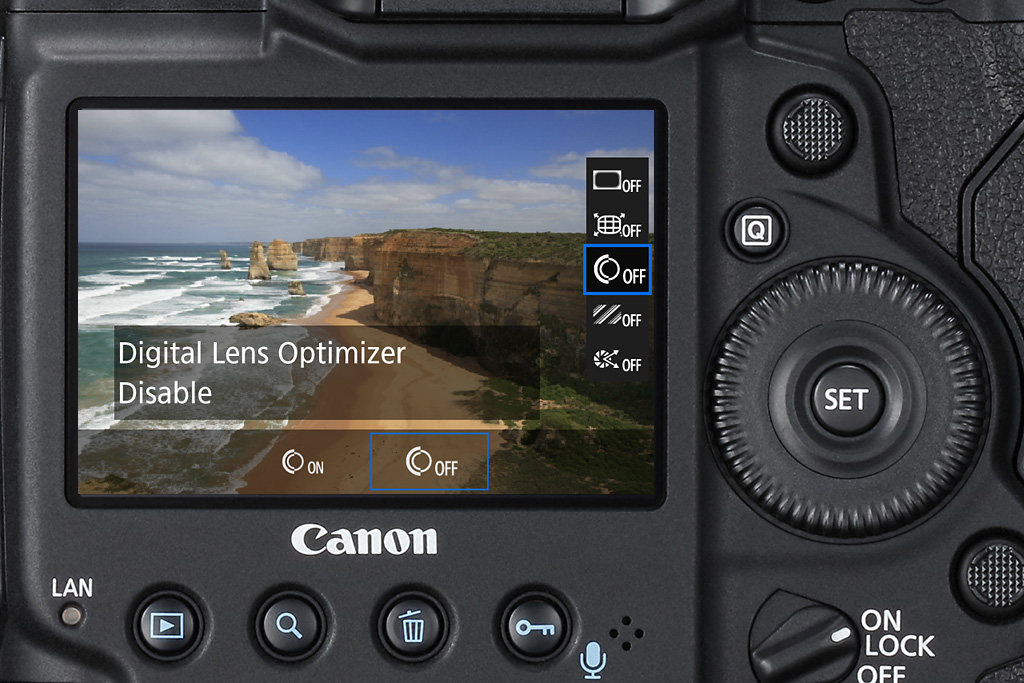It is natural that photo lovers want to capture beautiful images and pursue a high image quality. Released on February 2, 2016, the EOS-1D X Mark II is not only Canon’s flagship model that boasts an excellent level of shooting performance, but also a bold undertaking that takes image quality to the next level. In the following article, let’s take a look at the impact of the EOS-1D X Mark II on photography. (Reported by: Ryosuke Takahashi)

The history of EOS DSLRs reflects advancements in image quality
The history of the EOS Digital series, which started in 2000 with the release of the 3.11-megapixel EOS D30, can be equated to the history of advancement in image quality. 15 years later in 2015, we see the advent of an era of “super” high resolution and “super” high image quality with the launch of the EOS 5DS and EOS 5DS R, which boast a resolution that exceeds 50 megapixels.
Both the camera’s digital correction features and improvement in the lens image quality played an important role in making possible this huge leap in performance. With the release of Canon’s flagship model, the EOS-1D X Mark II, in February 2016, in-camera real-time aberration correction has evolved even further, and finally the Digital Lens Optimizer functionality is equipped in-camera as well. The purpose of these features is to tackle the different types of aberrations that optical correction is not capable of handling with the use of digital technology. With these advanced technologies, it is made possible for everyone to effectively and comfortably use a high image quality camera.

The EOS-1D X Mark II was released on February 2, 2016. Boasting superb specs such as a continuous shooting speed of 16 fps, this flagship model is packed with digital correction features for users who wish to pursue higher image quality.
For more details of the EOS-1D X Mark II, please click here
Aberrations cause deterioration in the image quality
Let me first summarise the impact of aberrations on the image quality of a photo. A camera captures light through a lens to form an image, which is then turned into a photo by the image sensor. From an optical perspective, the ideal situation would be for the image to be formed on a single point during this process. However, due to the different wavelengths of light and the position on the lens that the light passes through, the image takes a different shape and/or is formed at different positions. This phenomenon is known as aberration, and is also one of the reasons that cause deterioration in the image quality. Regardless of the level of lens performance, an unavoidable fact that characterises all lenses is that they can never be completely free of such aberrations.
In order to suppress aberrations, it is necessary to possess a high level of know-how and lens development technology, particularly in order to develop glass materials for lenses that can control light waves, to combine various lens elements, and to implement these in cameras. In recent years, the image quality of cameras has advanced by leaps and bounds, and thus there is also a growing need to suppress aberration.

This diagram illustrates how an image is formed through light that passes through the lens (taken from Canon Web). From an optical perspective, the ideal scenario would be for image to be formed on a single point. However, due to the fact that different wavelengths of light refract – or bend – at different points within the lens, slight dispersion occurs during image formation. This phenomenon is known as aberration, and it causes deterioration in the image quality.

Above is a diagram used by Canon to explain the different types of aberration. For more details, please click here.
The diagram above shows the “five Seidel aberrations” (monochromatic aberrations) that has been known since the film camera era, as well as chromatic aberrations. As can be seen, colour fringing and colour blur are seen in what was supposed to be reproduced as a point. Among these types of aberrations that cause deterioration in the image quality, axial chromatic aberration and spherical aberration become less noticeable when the aperture opening is reduced, while astigmatism and lateral chromatic aberration (chromatic aberration of magnification) cannot be improved by adjusting the aperture.
Diffraction – another problem arising from high pixel count
With the increase in the pixel count of cameras, one other problem to take into consideration together with the various lens aberrations is diffraction. Diffraction occurs when light waves are obstructed by a small opening (aperture), causing light to spread to the back of the aperture blades, thus reducing the resolving power. This phenomenon has been observed since the film camera era, but has not been discussed extensively as there was hardly any opportunity to blow up the image to life size for viewing. With the advent of the digital and high-resolution technology, life-size display of images can now be done easily, and deterioration in the resolving power due to diffraction has become an issue that needs to be addressed.

EOS 5D Mark III/ Aperture-priority AE (f/8 at 1/320 sec., f/22 at 1/40 sec. )/ ISO 100


Narrowing the aperture of a lens restricts light in the surrounding area of the lens from entering, thereby reducing the different types of aberrations. However, narrowing the aperture excessively may result in diffraction instead. Take the photo captured at f/22 as an example. The depictive performance of the camera and the lens is compromised as a result of diffraction. Thus, when you are narrowing the aperture to increase the depth of field, it is important that you identify the f-number at which the resolving power is at the peak, review the composition and point to focus on accordingly, to ensure that you do not narrow the aperture unnecessarily.
Canon’s approach to enhancing image quality
So far, we have explained that both aberration and diffraction cause the image quality to deteriorate. Canon has been making relentless research efforts to develop glass materials and processing technologies to address these issues on its EF lenses. As will be described below, Canon has established numerous in-house technologies in the past, most of which have been employed on L lens products. Of course, these sophisticated technologies can also be found in Canon’s range of more affordable lenses.
At the same time, Canon has also developed a new correction feature that makes use of digital technology to address aberrations that cannot be eliminated using optical technology. This feature is available as a separate software, as well as a functionality inside cameras. On the EOS-1D X Mark II, you can also find the Digital Lens Optimizer feature in-camera, which offers advanced correction processing using this software.

(from left to right) Fluorite lenses / DO lenses / BR lenses
Fluorite lenses – Pioneer of fluorite use in DSLR lenses
In place of natural fluorite, which is only available in the world in extremely small quantities, Canon succeeded in developing artificial fluorite crystals in 1969. These crystals come with optical characteristics that are capable of effectively eliminating residual chromatic aberrations. By suppressing all colour fringing they bring out a sense of high resolution. This key technology has been adopted in many EF lenses, particularly telephoto lenses, which are susceptible to the influence of residual chromatic aberrations.
DO lenses – Putting diffraction to good use
While diffraction has been regarded as an “optical flaw”, Canon puts the characteristics of such a flaw into good use on its EF lenses. By exploiting this phenomenon of light waves bending and controlling their path to an extreme degree, these lenses eliminate the chromatic aberrations which occur and are amplified when the lens is downsized. Grooves in the form of concentric circles ranging between the size of a few millimetres to 10 micrometers are created on the lens surface to replicate the characteristic of fluorite and aspherical lenses. By doing so, it is possible to downsize telephoto lenses, for example, while achieving high image quality.
BR lenses – Enable further chromatic aberration correction
Shown on the left is a photo of the revolutionary BR lens as well as the material used for making the lens. The powder is an organic optical material, which is employed to manufacture BR lenses, such as the one in the foreground for the EF35mm f/1.4L II USM. By including a convex and a concave lens element respectively in front of and behind the organic optical material, Canon succeeded in converging light to a single point. BR lenses are characterised by the ability to refract blue light considerably, and Canon is planning to make use of such an effect to correct chromatic aberrations further.

Distortion correction OFF

Distortion correction ON

Digital Lens Optimizer available to all EOS users
With the Digital Lens Optimizer featured in the Digital Photo Professional software it is possible to minutely correct lens aberrations and diffraction, which are the causes of deterioration in image quality. It offers a comprehensive solution to address aberrations that cannot be eliminated with in-camera correction. You can adjust the level of effect to obtain the intended image quality. The Digital Lens Optimizer is a highly versatile feature that is compatible with all the cameras in the EOS series.
EOS-1D X Mark II offers a one-stop solution
Enabling a wide variety of image processing options within the camera, the EOS-1D X Mark II has the ability to revolutionise your workflow from photo shooting to image processing. The advantages of this one-stop solution are immeasurable. Unlike before, it is no longer necessary to process images away from the location of your shoot, and you can correct the images you captured on the spot and send or share them immediately through the Internet. In the following, let us take a look at how aberrations can be corrected in real time and also the advantages that it offers.

The processing ability of the Dual DIGIC 6 + image processing engines is what makes in-camera image processing possible. They are capable of processing the vast amount of data that is yielded from the 20-megapixel sensor and the continuous shooting speed of 16 fps at a high speed, and achieve in-camera RAW image development and real-time aberration correction.

A dedicated IC has been developed and employed to enable the incorporation of different aberration correction features during in-camera RAW image. Issues that cannot be handled by the lens aberration correction features, such as coma aberration, sagittal halo, astigmatism and spherical aberration, are corrected based on the optical design values.
Advantages of real-time aberration correction
Not only does in-camera aberration correction help to speed up the work process, it is also extremely useful for enhancing the quality of your photographic works. By correcting optical flaws that could not be addressed in the past, it is possible to create an optimal environment for capturing the subject. Specifically, you can make full use of the depth of field without being subject to the constraints of the aperture. You can maintain a stable level of image quality regardless of the aperture setting, thus enhancing the flexibility of how you position the subject and compose a shot. These will allow you to bring out the character of each lens.

Advantages in landscape photography
- Able to select an aperture setting freely
- Able to reproduce the horizon faithfully
- Minimises chromatic dispersion at the edges of the image
In addition to blurring and distortions caused by diffraction, lateral chromatic aberration which cannot be controlled using the aperture is also one of the factors that may lower the quality of your landscape shots. By resolving these issues in real time, you can obtain a sharper image and reproduce the texture of rocks or the details of trees more faithfully. Also, with the greater ease in composing shots with the focus set on the foreground, you can also express depth in your images more effectively.

Advantages in nightscape and street photography
- Able to depict the shape of the subject accurately
- Able to reproduce point images sharply
- Produces clear images free of chromatic dispersion
Real-time aberration correction reproduces the horizon faithfully in a nightscape photo, and it enables the camera to correct diffraction and capture point images sharply, thus easing calculation of the optimal shutter speed when you want to create a slow shutter speed effect by narrowing the aperture opening, allowing you to express movement effectively according to the scene. In street photography, correcting distortions in real time makes it easier you to include a subject that is made up of straight lines into your composition.

Advantages in portrait photography
- No peripheral light fall-off at the four corners of the image
- Colour fringing is less likely to appear at the maximum aperture
- Reduces the influence of the low-pass filter for a sharper result
By enabling peripheral illumination correction, light fall-off does not occur at the four corners of the image, even at the widest aperture, which helps to create a lively feel. Furthermore, performing chromatic aberration correction helps to reduce colour fringing caused by axial chromatic aberration, thus producing an image that is more defined. Turning on diffraction correction reduces the influence of the low-pass filter as well, and allows you to bring out the point in focus more sharply while retaining the characteristically soft depiction when the aperture is fully open. The advantages are particularly evident when you are using a large-aperture lens, and since it is possible to check the impact of the different aberrations on your image in real time you can choose to turn on or turn off the optical correction feature freely.

Advantages in still photography
- Able to depict straight lines accurately
- Allows effective use of the depth of field
- Reduces colour fringing
Reducing distortions helps to reproduce objects such as boxes and wine bottles in straight lines, while it also helps to reduce colour fringing caused by chromatic aberration such as when you are taking a close-up shot of a flower or a piece of jewellery. Furthermore, by eliminating the influence of diffraction when the aperture opening is narrowed, it is possible to distinguish blurring caused by the aperture from blurring due to diffraction. This facilitates the accurate selection of the aperture and shutter speed settings you need for your image, while effectively reducing camera shake that tends to occur in close-up photography.
Advantages of using DLO during in-camera RAW image post-processing
The EOS-1D X Mark II is equipped with an IC that was specially developed to enable correction by the Digital Lens Optimizer (DLO) during in-camera RAW image post-processing. In addition to adjustment of the brightness and colour tone, aberrations can also be corrected more precisely. Also, the DLO feature on the camera is capable of correcting influences of the low-pass filter on the image, thereby enhancing the sharpness regardless of the aperture setting you choose. Data prior to post-processing is also retained, which can be used as a guide if you wish to perform more detailed adjustment during post-processing with the DPP software. These are some of the many advantages that help to enhance your work efficiency. Furthermore, you can now build a more pleasant workflow given the freedom to choose between processing your RAW images in-camera or with DPP depending on the intended use of your photo.

The Digital Lens Optimizer feature can be used during in-camera RAW processing on the EOS-1D X Mark II. The aberrations it is capable of correcting include coma aberration, sagittal halo, astigmatism, spherical aberration and field curvature. These corrections are performed using correction values calculated based on the lens design values. It can also handle changes in the aberration according to the focal length. Please note that S-RAW and M-RAW images cannot be processed with the camera.
Summing up: Canon pursues higher image quality through the integration of optical and digital technologies
Needless to say, the source of all technologies is attributable to both the skills of the technicians as well as their vast amount of knowledge. At Canon, such wisdom is consolidated into data and put to good use in product development. Such data are utilised, for example, for lens correction by the in-camera aberration correction features and the Digital Lens Optimizer. This integration between optical and digital technologies is undoubtedly possible because it is Canon. It is likely that such interaction between optical and digital technologies will bring about further improvements to the performance of optical products and further advancement of correction data to a higher level.

Ryosuke Takahashi
Born in Aichi in 1960, Takahashi started his freelance career in 1987 after working with an advertising photo studio and a publishing house. Photographing for major magazines, he has travelled to many parts of the world from his bases in Japan and China.

































